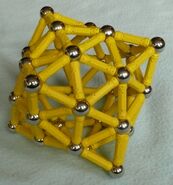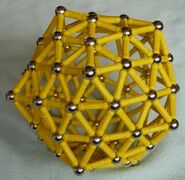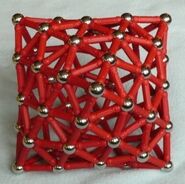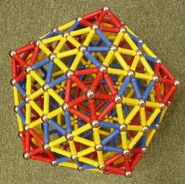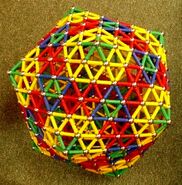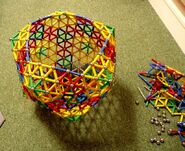| Creased Platonic Deltahedra | |
 ' | |
| Type | Polyhedron |
| Rods | 3F(3p2+3pf+3p2)/2 × |
| Spheres | 2+Rods/3 × |
| Author | --Leo Dorst 07:45, 30 August 2008 (UTC) |
You can make families of large Platonic solids with triangular faces (deltahedra), made sturdy by `creasing' their edges
to become dome-like.
The shapes that results are all deltahedra, and although the principles of construction are similar, very few are Lobel frames (presumably since they cannot be cut in a straight manner to make them architecturally interesting).
There are three parameters to each family member:
- the type of basic Platonic deltahedron: tetrahedron, octahedron or icosahedron (and even the dihedron makes sense)
- the size of a pyramid at the vertex (see building instructions)
- the size of the triangular face (see building instructions)
The sum of those last two parameters determines the edge length of the result.
Here is part of the family (v,1,f), for the notation see the building instructions.
Building Instructions
Take any of the triangular faced Platonic solids - tetrahedron, octahedron or icosahedron that you want to enlarge. Let F be the number of faces (so 4, 8 or 20).
- The valence of the Vertices is v = 6F/(4+F), so 3, 4 or 5. The total number of Vertices is V = (4+F)/2, so 4, 6 or 12. Build V pyramids with a v-gonal base. For your first attempt, make a pyramid of edge length 1; later, make it a p of your choice.
- Decide on the size of polyhedron you want to build, in terms of edge length n (but take at least n=3 for your first attempt, see below). Build triangular mats of size f = n-2p for each of the F faces.
- Now connect the mats to the pyramids in the basic shape of the F-hedron (taking out one corner ball for each connection).
- Give the pyramids a slight twist, and put in rods for the edges, connecting the triangular faces with edge triangles.
(If you have taken p=1, this is mere 'stitching', for larger p you need to add p-1 rows of balls,
of length f-1.)
The above procedure needs to be slightly modified when the mat size is zero, since then some of the pyramidal base edges are shared, and they should be removed. And for the dihedron, some rods count mathematically multiple times, but they can only be put in once in Geomag. I sometimes use a deviating color to denote that multiple use of a rod.
The rod and ball count, as well as their deltahedron characteristic are, for an F-hedron with pyramid size p and facelet size f
(so that the edge length is 2p+f):
- The number of rods is 3F(3p2+3pf+3p2)/2.
- The number of balls is 2+(number of rods)/3.
- Deltahedron: there are V=(4+F)/2 vertices of valence v=6F/(4+F), the rest of valence 6 (though for F=2, only when you count multiplicities for some rods).
These formulas show that even when you do not want to build a polyhedron (i.e.,f=0 and p=0), you still need 2 balls!


